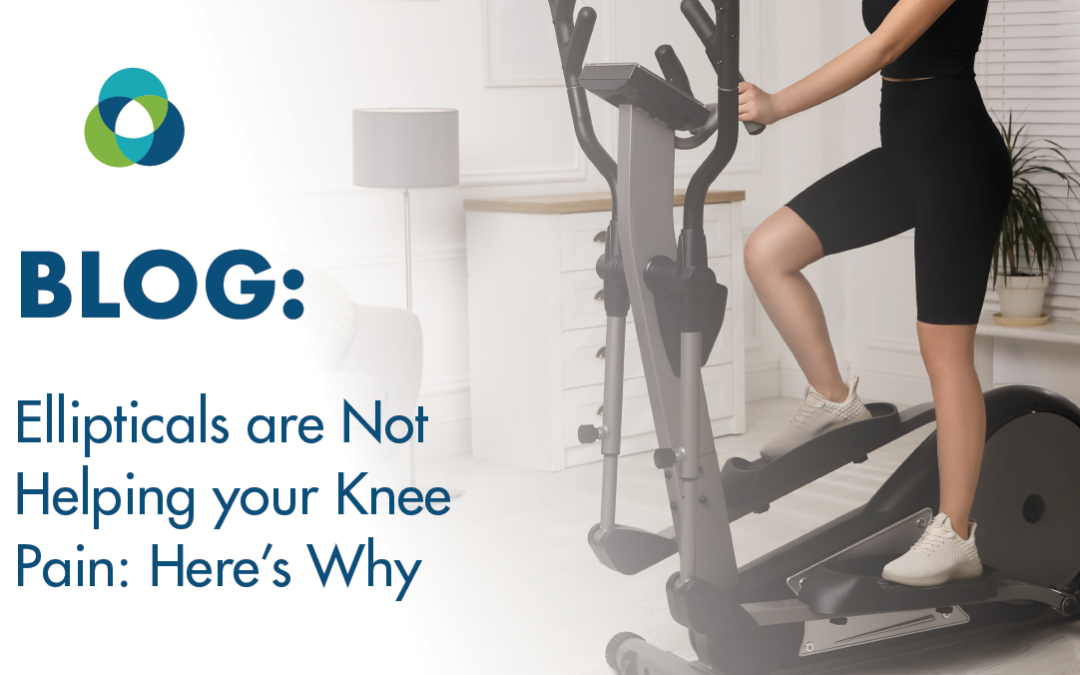If you’re an avid gym-goer, then chances are you’ve spent time using the all-popular elliptical machine at least once before. This cardio machine first gained traction in the 90s and is still commonly used today. It became famous as a low-impact cardio exercise known to increase heart rate, burn calories and aid in weight loss without the pain and injury associated with running or jogging. Yet, despite this exercise being praised for its low-impact qualities, many still feel pain after stepping off the machine. So, how could ellipticals be contributing to your knee pain and how can Synergy help?
How Does an Elliptical Work?
The elliptical engages the whole body on a vertical plane by combining the movements of running, stair climbing and skiing. The only difference is that the involved joints and muscles do not reach their full range of motion since your feet are planted firmly on the platform instead of lifting from the ground. Because of this artificial movement, your natural gait changes and leads to knee pain because it is inconsistent with the body’s natural joint motion.
Common Factors Contributing to Knee Pain
Improper Alignment – The elliptical forces your body to be in a fixed position against proper alignment. So, you could strain your knees if you’re not appropriately positioned while using the elliptical machine. For example, if your hips are wider than the foot pedals, your knees may bow inward, placing stress on the joint. In addition, the elliptical requires you to exercise on the balls of your feet, which engages the quadriceps muscles. This movement can pull on the patella or kneecap and cause sharp or shooting pains across the knee.
Lack of Intensity – For many, lack of muscular strength is among the leading causes of knee pain after excess use and injury. Because weak muscles don’t absorb enough of the stress exerted on the joint, knee pain persists. Due to their low intensity, ellipticals may not provide enough challenge to build the necessary muscle to protect your knee. In addition, the low-impact design of the machine often leads to overuse injuries in the knee and hip joints because users tend not to realize that they are doing more than they’re physically able.
Imbalanced Force – The ability to withstand a certain amount of force with good form is known as load tolerance. Those with knee pain usually have a load tolerance equal to less than their body weight. So, if your load tolerance is equivalent to only 50% body weight, there’s a good chance that the elliptical machine will have too much load. The lack of weight-bearing pressure on bones and joints during elliptical exercise can cost you bone density and muscular strength, keeping your knee pain more persistent.
Not Taking a Rest Day – Like with any exercise, adequate rest and recovery are essential. Therefore, you should take at least one day off between elliptical training to prevent overload and persistent injuries.
Say Goodbye to Knee Pain with Synergy
Here at Synergy Health, we believe in a multi-step approach to care. We get to know each of our patients to determine the root cause of their pain and aid in relief. Our expert team offers everything from chiropractic and physical therapy to injection therapy, non-invasive treatments and more. Contact us today for a customized treatment plan and say goodbye to knee pain once and for all!





I Have Knee Pain In Both Knees, I Have Been Using A Elliptical For A Few Day And My Pain Has Become WORSE !!!!
I’m sorry to hear about that Clifton. Get well soon
Hey Clifton Turner,
How long does your pain last or does it go away on its own? Because I have same pain after using a elliptical
I’m afraid I barely walk
Me, too.
I have been using the Ellipse daily for a week now and do not feel it is making my knee pain worse. I had a knee replacement that didn’t go well and left me with worse pain. The exercise from the Ellipse seems to be helping with the stiffness. I cannot walk that far and love this machine.
I want to drop 100. I’m also a new vegan because I can’t handle meat or too much protein. I have kidney disease!
WHAT ABOUT UNDER DESK ELLIPTICAL EFFECTING KNEES
I purchased a new elliptical machine electric that you sit down and do and my knees hurt. I had knee replacement 6 yrs ago age 79 but not a lot activity daily.